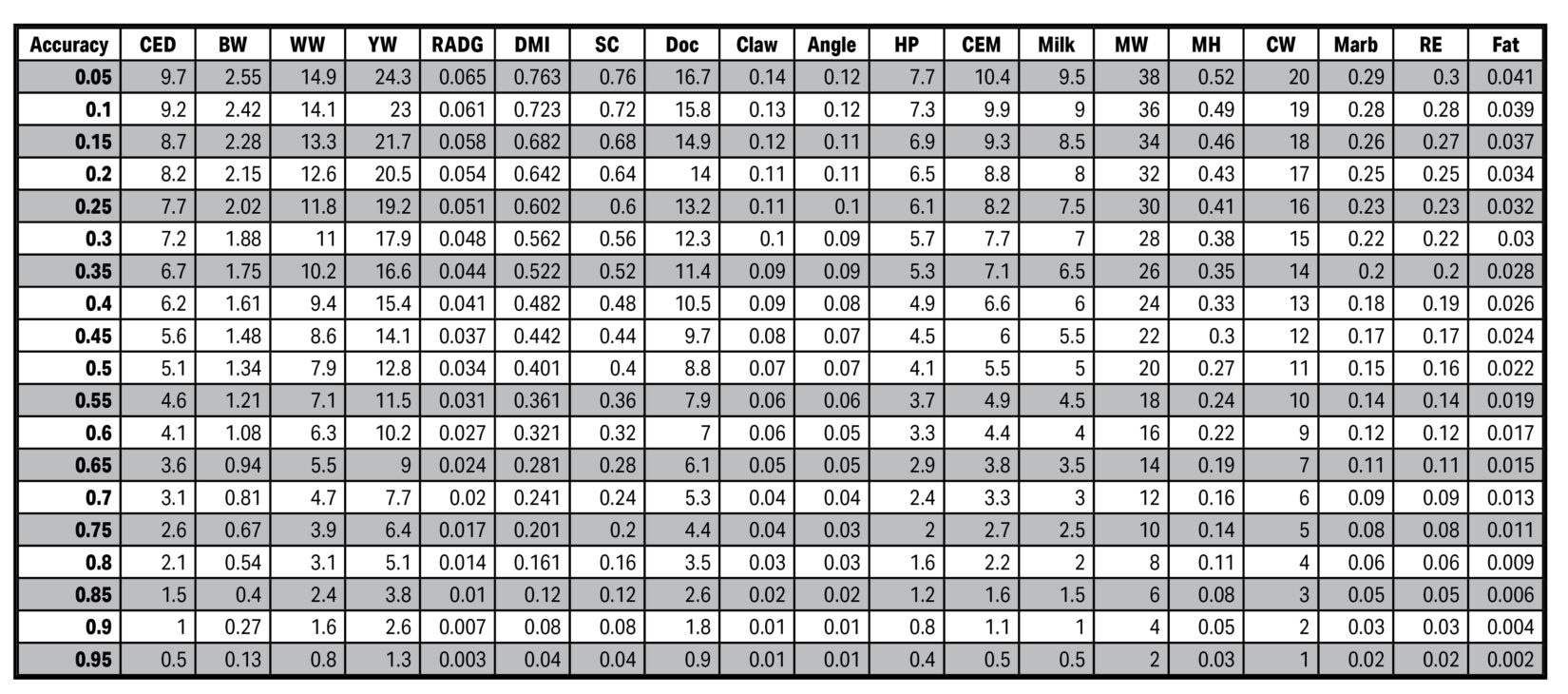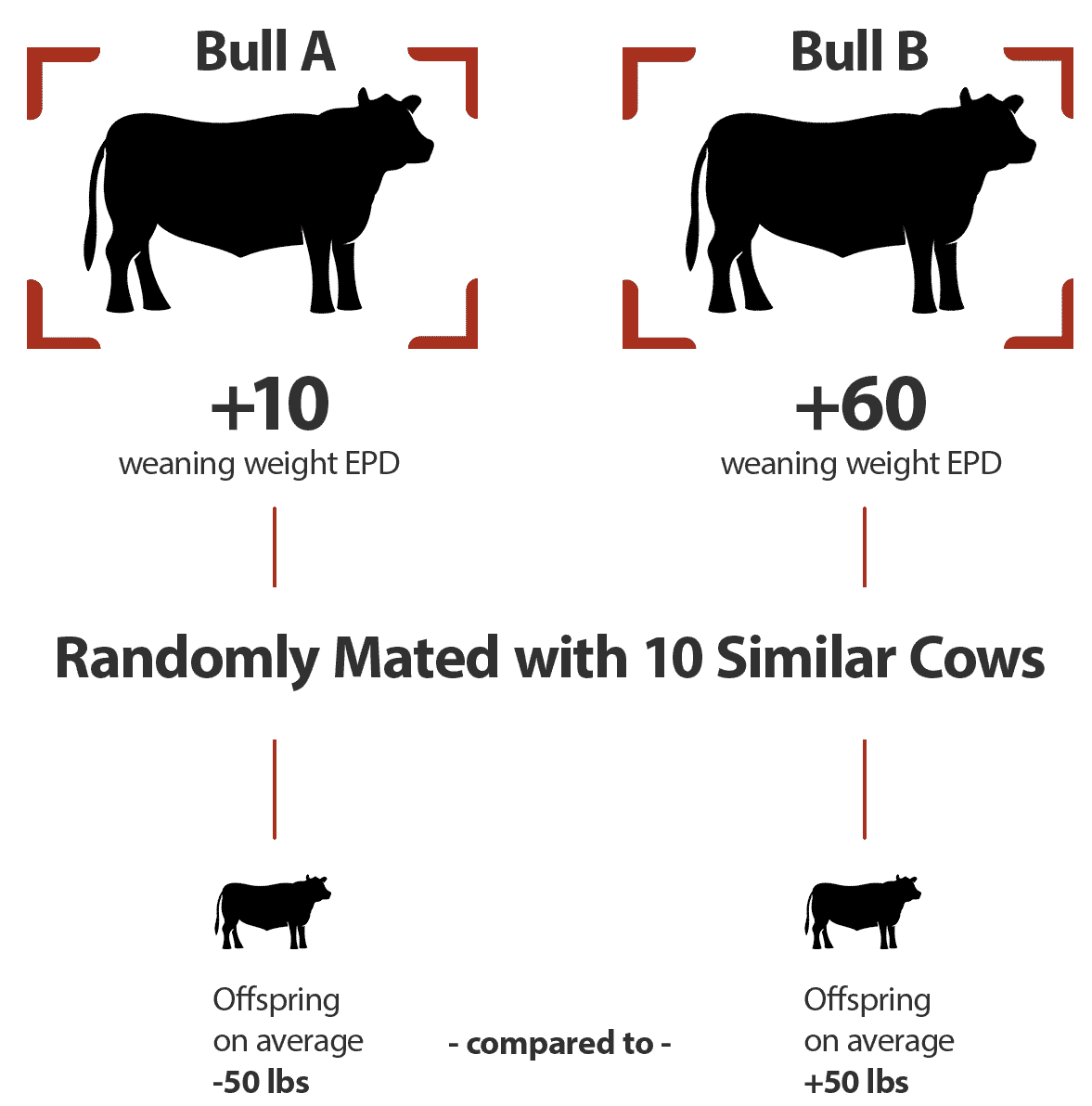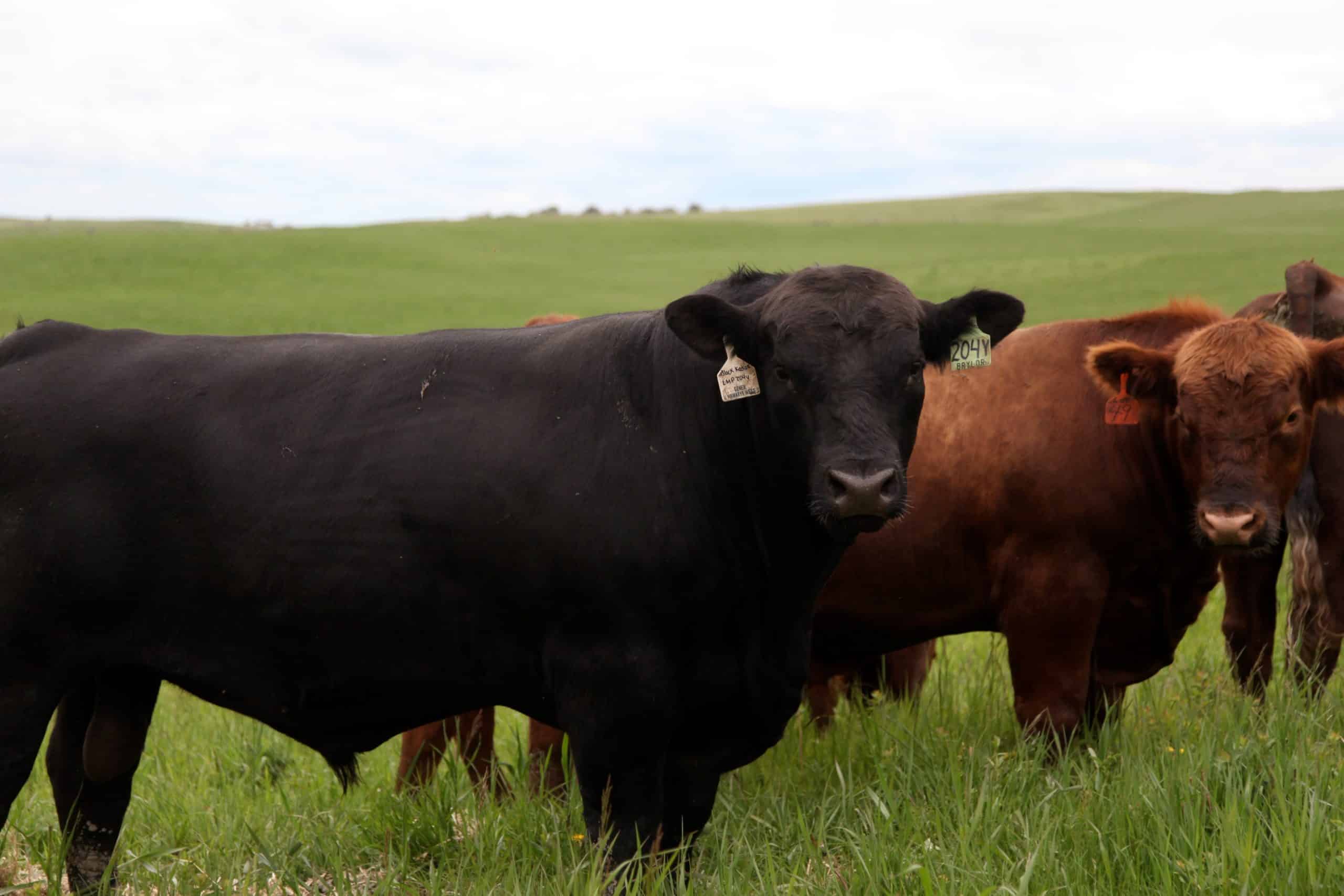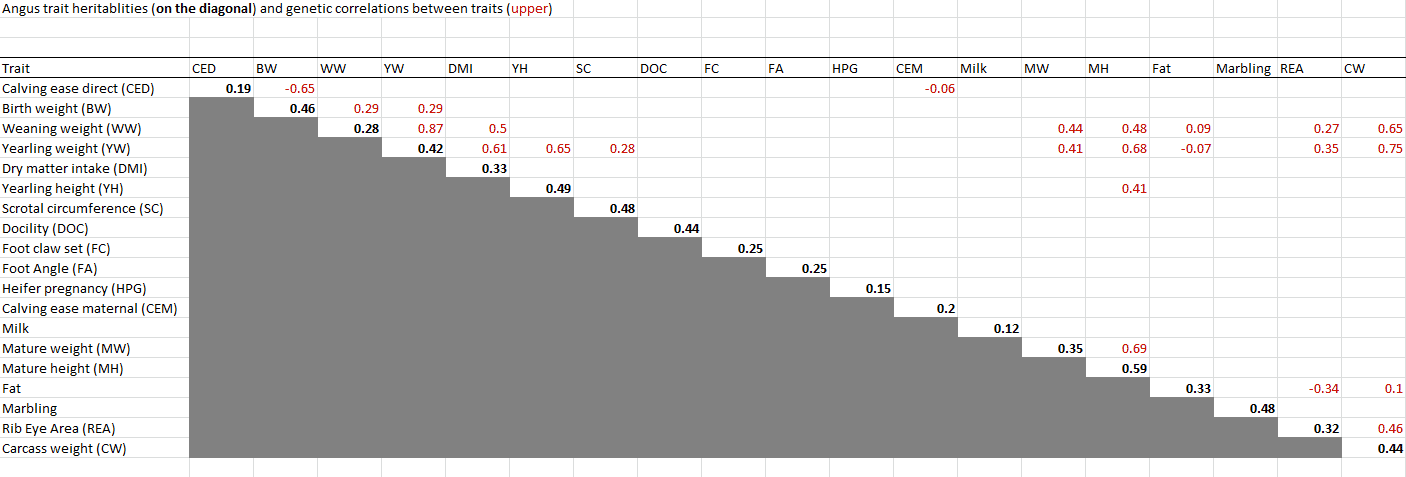
Expected progeny differences (EPDs), generated through our World Angus Evaluation genetic evaluations, are predicted breeding values that allow for fair comparison of animals across herds, regardless of environment and management differences. They are expectations of how an animal’s progeny will perform, on average, for specific economically relevant traits.
Expected Progeny Differences (EPDs) are the most powerful genetic tool we have for selecting the best animals for your breeding program.
EPDs are values that predict how the future progeny of an animal will perform relative to the progeny of other animals in the same breed. They are expressed in the units of that particular trait. For example, weaning weight is measured in pounds thus the Weaning Weight EPD is expressed in pounds. Another way to look at it is EPDs measure an animal’s value as a parent.
EPDs are based on pedigree information and performance data such as weight information and are then compared to other animals within a contemporary group. The different traits are adjusted to a standard age to ensure that all animals are equal when they are compared.
EPDs are useful tools when planning breeding programs.
Attention should be paid to the heritability—the proportion of variation for a particular trait that is determined genetically—and correlations to the traits a breeder wants to improve upon within the herd. Some traits are more heritable than others resulting in faster progress being made in comparison to other less heritable traits. Also, many traits are correlated, wherein the trait is affected by the expression of several other traits. It is important to be aware of such logistics when developing selection criteria in a breeding program.
The higher the heritability of a trait, the more accurately an individual’s own performance will predict its breeding value for this trait. Calving Ease and Milk have lower heritability. This means that there are a lot of factors in addition to genetics that influence these traits, and a cow’s own milking ability does not reflect her daughters’ milking ability to a high degree. Conversely, growth traits are moderately heritable and carcass traits are highly heritable.
EPDs are useful tools when planning breeding programs. Attention should be paid to the heritability and correlations to the traits a breeder wants to improve upon within the herd. Some traits are more heritable than others resulting in faster progress being made in comparison to other less heritable traits. Also, many traits are correlated, wherein the trait is affected by the expression of several other traits. It is important to be aware of such logistics when developing selection criteria in a breeding program.
Understanding the heritability and the effects of correlation between traits will aid in developing a genetic selection program that will optimize improvement on desired traits while minimizing undesirable side effects.
Each individual breeder must set his own selection goals based on the needs of his operation, the situation for that trait in his herd, and his production environment.
Breed Averages
Released April 2024 Black and Red Angus
Average EPDs for all Red and Red Carrier Calves born in 2023 Click for Percentiles | ||||||||||||||||||||
| Calving Ease | Birth Weight | Weaning Weight | Yearling Weight | RADG | DMI | Scrotal Circ. | Docility | Claw | Angle | Carcass Weight | Marbling | REA | Fat | HPG | Mat Calving Ease | Milk | Mature Weight | Mature Height | CBI | |
|---|---|---|---|---|---|---|---|---|---|---|---|---|---|---|---|---|---|---|---|---|
| EPD | +3.5 +2.7 | +2.0 +1.2 | +54 +43 | +95 +74 | +0.24 +0.19 | +0.91 +0.36 | +0.86 +0.77 | +18 +14 | +0.44 +0.43 | +0.45 +0.49 | +43 +26 | +0.48 +0.23 | +0.53 +0.39 | +0.018 +0.003 | +11 +10 | +6.7 +5.4 | +23 +25 | +60 +43 | +0.4 +0.3 | +287 +227 |
Possible Change Table
This table provides EPDs users an estimate of how much an EPD could change based on its accuracy. An YW EPD with a 10% accuracy may change +/- 23 lb as more information on the animal becomes available. In comparison, a YW EPD with a 90% accuracy is within +/- 2.6lb of the animal’s true breeding value for YW. It is possible to calculate more accurate EPDs when there is more performance, pedigree, progeny and genomic information available on an animal. The higher the EPD accuracy, the more confidence the producer can have in it.

Commercial buyers rely on EPDs to make their purchasing decisions
Producers that do not have EPDs for their animals often lose out on selling their animals because of this. Buying an animal with EPDs provides a genetic snapshot of an animal’s breeding potential. While appearance and pedigree should be considered, EPDs allow a fair comparison of breeding value by removing environmental bias such as climate, feed and special management.
Depending on your target market, you can improve your herd by selecting for the right traits. Choosing a bull with high growth EPDs, in particular, the weaning weight EPD, means more pounds at sale time. Looking at the EPDs of a prospective bull is essentially just as important as looking at specifications of an engine when buying farm machinery or vehicles.
To evaluate seedstock, use a combination of EPDs, pedigree and visual assessment. With EPDs, the concept of “intermediate optimums” works best.
Selection for one trait or for extremes generally results in unexpected consequences due to genetic correlation. For example, intense selection for high yearling weight will also increase birth weight. Successful cattle breeding requires a thoughtful and balanced approach to optimize fertility, growth and carcass merit while improving profitability and efficiency. EPDs are the best tool we currently have to compare animals between herds and countries.
The quality of your EPDs also reflects the quality of data that comes into the office. Taking pride in your paperwork increases error-free data entry. Submitting your data on time or early eliminates the chances of receiving a Missing Data Report and your animals subsequently not getting EPDs due to non-compliance.
To ensure that your animals receive EPDs you must:
- Enroll in the Performance Program
- Submit weaning weights on all of your animals
- Ensure your animals are within the acceptable age ranges: 120–280 days for weaning weights (WW) and 290–440 days for yearling weights (YW) for all Angus animals
- Animals that are in a management group of their own, such as twins, fosters, ET calves and lone bull calves are automatically placed into a single animal contemporary group and will not receive EPDs until they are parents to performance-recorded progeny or genotyped.
EPD Accuracy
Canadian Angus Association provides breeders who participate in the Performance Program with two levels of EPDs:
Parental Average EPDs: These are the most basic and least accurate EPDs. They are the best guideline available when calves are first reported and there is no performance data on them yet. Parental Average EPDs are indicated by a P for accuracy and are simply an average of the dam and sire’s EPDs.
World Angus Evaluation EPDs: The World Angus Evaluation for all Canadian Angus cattle (Black and Red Angus), American and Australian Angus cattle, was launched in October 2023. There are many advantages to the World Angus Evaluation, including the combined Canadian Angus, American Angus, and Australian Angus data which gives us the ability to calculate more accurate EPDs. Together, the Canadian Angus Association, American Angus Association and Angus Australia genetic evaluation includes more than a million animals that have been genomically tested. The World Angus Evaluation has also allowed us to expand your genetic evaluation and bring you EPDs for new traits that we believe are priorities for the industry, and economically relevant to you.
Example of EPD Use
To use EPDs effectively you must understand how they work.
Imagine you are interested in purchasing a couple of bulls for your herd.
You are looking at the EPDs in a sale catalogue. Bull A has a weaning weight EPD of +10 and Bull B has a weaning weight of +60. What does that mean? How can you use the EPDs to choose between the two bulls?
If these animals were randomly mated with 10 similar cows, we would expect the group average weaning weight of Bull A’s offspring to be 50 lbs lighter than that of Bull B’s (60-10=50).

Sire Selection
It would be easier if we could assume that the highest EPDs are the best. Unfortunately, it isn’t that simple. Like most decisions, using EPDs for sire selection involves trade-offs. For example, bulls with high growth EPDs may sire calves with a higher birth weight as well. And there may be other impacts on your operation to consider.
It should also be kept in mind that reaction to selection can differ from trait to trait. This is because some traits have higher heritability than others, and are more easily passed to offspring. For instance growth traits such as weaning weight respond faster to selection than reproductive traits such as age at first calving.
A balance of traits is required, and the perfect balance for you will depend on your climate, nutritional and economic environment, as well as the management goals you have set for your herd.
One way to select for several traits is to set minimum and maximum acceptable levels for each trait, and then choose sires that meet the criteria. Another method would be to rank all sires on each trait, then develop a weighted index which ranks each bull from one (most desirable) to five (least desirable) for each trait. The bull with the lowest total score would be your first choice.
A Sample Sire Evaluation
| Bull | Birth Weight | Weaning Weight | Yearling Weight | Milk | ||||
| EPD | Acc. | EPD | Acc. | EPD | Acc. | EPD | Acc. | |
| A | 6.6 | 0.75 | 31.3 | 0.75 | 39.5 | 0.68 | -5.6 | 0.58 |
| B | 0.1 | 0.82 | 14.6 | 0.83 | 24.6 | 0.80 | 6.0 | 0.73 |
| C | 0.0 | 0.89 | 0.3 | 0.89 | 11.1 | 0.88 | 18.9 | 0.87 |
| D | -5.9 | 0.87 | -3.8 | 0.87 | -14.4 | 0.86 | 10.3 | 0.85 |
Producer 1 is looking for a sire that can be used on heifers; he wants a bull that will produce low birth weights and he wants to keep some heifer calves as replacements. Growth performance is not his first priority. The sire that fits his needs is sire D. He has a low birth weight EPD and above-average milk EPD.
Producer 2 has a sound breeding program; he is looking for a sire that will maintain performance and milking ability. He will select a bull that will increase growth performance and milk while maintaining calving ease. Sire B is his choice.
Producer 3 has a herd of above-average-frame cows and is not planning on keeping heifers as replacements. She is looking for a bull that will give her the most profit at weaning. Sire A will give her the best result in weaning weight. If heifers are kept as replacements, they will, on average, be inferior for maternal milk.
Producer 4 wants to maintain his calving performance and growth performance but would like to increase the milking ability in his females. Sire C is his choice.

World Angus Evaluation Genetic Evaluation
Calculate More Accurate EPDs
The World Angus Evaluation for all Canadian Angus cattle (Black and Red Angus), American and Australian Angus cattle, was launched in October 2023. There are many advantages to the World Angus Evaluation, including the combined Canadian Angus, American Angus, and Australian Angus data which gives us the ability to calculate more accurate EPDs. Together, the Canadian Angus Association, American Angus Association and Angus Australia genetic evaluation includes more than million animals that have been genomically tested. The World Angus Evaluation has also allowed us to expand your genetic evaluation and bring you EPDs for new traits that we believe are priorities for the industry, and economically relevant to you.
These traits include:
Residual Average Daily Gain (RADG) is a measure of an animal’s genetic ability for growth (post weaning gain) on a constant amount of feed. This RADG EPD will help you identify animals that can grow more on a constant amount of feed.
In order to calculate RADG EPD for you, your Association requires the following data for your cattle which can be submitted by you and/or Growsafe:
- Feed intake data must be collected between 160–480 days of age, with a test minimum of 45 days and 14 days adjustment period.
- Weaning weight, yearling weight, and in and out weights must also be recorded
- Must be in a contemporary group of at least 2 animals
*To arrange to test your cattle for feed intake please contact a Growsafe partner in your region, or one of the below options:
Lakeland College:
Feeding tests can occur anytime in the year but two months’ notice is required before commencement of trial. The test is currently a 70-day intake test with a 21-day warm up period. The minimum number for feed test is 20 head, ration ingredients will vary but will be formulated for bulls to gain 2.5 to 3 lbs per day while heifers will target 1.5 to 2.5 lbs of ADG per day. Feed test costs depend on market cost of feed (the typical range is $4.50 to $5.50/ head/day).
*To arrange for feed intake testing at Lakeland College please contact Obioha Durunna, at Obioha.Durunna@lakelandcollege.ca or by calling 780-853-8481
The Technology Access Centre for Livestock Production (TACLP) at Olds College is also conducting feed intake testing using GrowSafe feeding systems.
*To learn more about the TACLP or for more information on accessing these services, contact Sean Thompson, TACLP Manager, at 403-556-8314 or sthompson@oldscollege.ca.
Maritimes Bull Test Station is also equipped with Growsafe feed intake test systems.
*To arrange to test your cattle here contact Brad McCallum at 902-661-2855.
Cattleland National Bull Evaluation Centre has a capacity of 5,000 head that includes options for feed testing and marketing cattle.
*For more information on feed testing your cattle at Cattleland please contact Kristine Burgess at Kristine@cattleland.ca or 403-333-5607.
Docility EPD is a measure of yearling cattle temperament, where higher numbers on parent animals indicate more docility in their calves.
• Submitted on AngusNOW and CAA worksheets
1 = Docile (acceptable, mild disposition)
2 = Restless (restless during processing)
3 = Nervous (nervous and impatient)
4 = Flighty (jumpy and out of control, quivers and struggles)
5 = Aggressive (extreme agitation) 6 = Very Aggressive (extremely violent behaviour)
Heifer Pregnancy EPD is a selection tool to increase the probability of a sire’s daughters becoming pregnant at first exposure. A higher EPD number indicates higher probability of pregnancy.
Mature Weight EPD is a measure of a sire’s genetic potential for mature weight of daughters.
Foot Angle EPD will measure genetic potential for foot angle, where the ideal is a 45-degree angle at the pastern joint with appropriate toe length and heel depth. A lower number EPD is more favourable, indicating that a sire will produce progeny with more ideal foot angle.
Foot structure has a heritability estimate of 0.25, which is similar to weaning weight. This means genetic improvement for these two claw set and foot angle can certainly occur. In order to calculate the most accurate EPD for these two traits we need consistent and accurate data on claw set and foot angle.
Canadian Angus members are now able to score their cattle for claw set and foot angle at yearling, and subsequently when scoring mature cow weight. Claw set and foot angle scores range from 1–9 and the scoring scale is shown here. Management group information should group animals that have been fed and managed the same together. Complete groups (all the animals in each group) should be scored and submitted.
*Claw set and foot angle scores can be submitted on AngusNOW.
Teat and Udder EPDs will be a measure of genetic potential for teat size and udder suspension. Higher EPDs will be favourable.
Pendulous udders that have lost their suspensory support and large bottle shaped teats have been associated with increased mastitis in the cow, and delayed teat finding and suckling by her calf. This results in early culling for the cow and financial loss for the producer. Teat and udder structure is important to both seed stock and commercial producers therefore your Canadian Angus Association has developed a genetic evaluation for the traits.
Teat size and udder suspension can be measured using the scale as follows: Scores range from 1 for large, bottle shaped teats to 9 for very small teats and from 1 for very pendulous udders with a broken floor to 9 for very tight udders.
Members are encouraged to score their cows at calving and submit their scores on AngusNOW when registering calves. These scores will be used to generate teat and udder score EPDs.
Cow Longevity EPD plays an important role in the profitability, sustainability, and environmental footprint of a beef operation. Canadian Angus members enrolled in the Performance Program have for the past 30 years provided whole herd reporting (complete cow herd data). Production and cull information on these cow herds is being used by your Canadian Angus Association and the American Angus Association to develop a Cow Longevity EPD.
Gestation Length EPD will be a measure of a sire’s potential to have calves that are born within fewer days from conception. A lower number will be indicative of shorter gestation length. Gestation length EPDs are a great tool for selecting for shortened gestation length with is associated with higher calving ease and lower birth weight without compromising on growth potential. A shorter gestation period also gives females longer to recover and cycle back into heat so this is a valuable EPD.
High Immune Response EPD—this project is funded by Genome Canada, and the Canadian Angus Association, American Angus Association and Semex Beef have come together to develop the University of Guelph High Immune Response (HIR™) test and EPD for Canadian and American Angus cattle because of the benefits that cattle that are naturally, genetically, healthier and more productive.
The consumer wants assurances that their beef is coming from healthy animals that are raised using sustainable practices. Genetic selection is often the best solution available. High immune response is hereditary and can be selected for in breeding programs. A high immune response test and EPD will help Angus producers identify animals that have superior genetic potential for high health, allowing the industry to capitalize on all the benefits of healthier animals, including decreased use of antibiotics.
Using EPDs for Bull Selection
EPDs are a genetic selection tool that some producers appreciate and use to select their bulls.
EPDs are calculated using pedigree, performance and genomic data. Canadian Angus members participate in the voluntary Performance Program through which they collect and submit performance data on fertility, calving ease, growth, structure, carcass quality, and feed efficiency for their calves. A big thank you to all our members who take the time to measure and record this data; without you we cannot generate the genetic selection tools that we do.
Many members have started measuring and submitting phenotypes for the new traits introduced here. As you start calving, please do not forget to record teat and udder scores on your cows.
Canadian Angus Association Genetic Evaluation Definitions
Production EPDs:
Calving Ease Direct (CED) EPD describes the percentage of expected unassisted births when a bull is exposed to first-time heifers. The higher the number, the higher the probability that first-time heifers bred to the bull in question will calve with no assistance. The EPD predicts the average difference in ease with which a sire's calves will be born when he is bred to first-calf heifers.
Birth Weight EPD (BW) EPD describes in pounds the difference in expected progeny weight, on average. A bull with a BW EPD of +4 will, on average, sire calves that are 2 pounds heavier than a bull with a BW EPD of +2 (given equal management).
Weaning Weight EPD (WW) EPD describes in pounds the difference in expected weaning weight in progeny, on average. WW EPD is a predictor of a sire's ability to transmit weaning growth to his progeny compared to that of other sires. A bull with a WW EPD of +50 will sire calves that are, on average, 20 pounds heavier at weaning than a sire with a WW EPD of +30 (given equal management).
Yearling Weight EPD (YW) EPD describes in pounds the difference in expected yearling weight in progeny, on average. YW EPD is a predictor of a sire's ability to transmit post weaning growth to his progeny compared to that of other sires. A bull with a YW EPD of +100 will sire calves that are, on average, 30 pounds heavier at weaning than a sire with a WW EPD of +70 (given equal management).
Residual Average Daily Gain (RADG) EPD describes an animal’s ability to grow post weaning on a constant amount of feed. RADG EPD, expressed in pounds per day, is a predictor of a sire’s genetic ability for postweaning gain in future progeny compared to that of other sires, given a constant amount of feed consumed. A bull with an RADG EPD of +1.5 will sire calves that, on average, will grow 1 extra pound per day more than calves from another bull with an RADG EPD of 0.5—on the same amount of feed.
Dry Matter Intake (DMI) EPD describes the feed intake potential for weaned calves from one sire compared to the feed intake potential of calves from another sire. This EPD is expressed in pounds per day. Weaned calves from Sire A with a DMI EPD of 0.50 will eat approximately 0.5 pounds of dry matter a day more than weaned calves from Sire B with a DMI EPD of 0.00. This EPD should also be used in conjunction with a growth EPD, such as YW EPD, as unlike RADG EPD, it does not include a growth component. Used independently of a growth EPD the DMI EPD selects solely for appetite.
Scrotal Circumference EPD (SC) EPD describes the difference in average scrotal circumference in sons. Expressed in centimetres, a sire with an SC EPD of 1.2 will, on average, have sons with scrotal circumference that is 1 centimetre larger than the sons from a sire with an SC EPD of 0.2. SC EPD has also been correlated with daughter’s age at puberty and progeny fertility.
Docility (Doc) EPD is expressed as a difference in yearling cattle temperament, with a higher value indicating more favourable docility. It predicts the average difference of progeny from a sire in comparison with another sire’s calves. In herds where temperament problems are not an issue, this expected difference would not be realized.
Claw Set (Claw) EPD is expressed in units of claw-set score, with a lower EPD being more favourable indicating a sire will produce progeny with more functional claw set. Ideally, toes are symmetrical, even and appropriately spaced.
Foot Angle (Angle) EPD is expressed in units of foot-angle score, with a lower EPD being more favourable indicating a sire will produce progeny with more ideal foot angle. The ideal is a 45-degree angle at the pastern joint with appropriate toe length and heel depth.
Carcass EPDs:
Carcass Weight (CW) EPD is expressed in pounds and is a predictor of the differences in hot carcass weight of a sire's progeny compared to progeny of other sires. A bull with a CW EPD of +30 will sire calves that, on average, will result in 10 pounds more hot carcass weight than the progeny of a bull with CW EPD of +20.
Marbling (Marb) EPD describes the marbling potential of calves from one bull compared to the calves from another bull, given the same management. This EPD is expressed as the difference in grade score. Given the same management, the calves from a bull with a Marb EPD of 0.6 will marble ½ a grade score better than the calves from a bull with a Marb EPD of 0.1.
Ribeye Area (REA) EPD describes in square inches the difference in ribeye area of a sire's progeny compared to progeny of other sires.
Fat Thickness (Fat) EPD expressed in inches, describes the differences in back fat thickness at the 12th rib (as measured between the 12th and 13th ribs) of a sire's progeny compared to progeny of other sires.
Maternal EPDs:
Heifer Pregnancy (HPG) EPD is a selection tool to increase the probability or chance of a sire's daughters becoming pregnant as first-calf heifers at first exposure. A higher EPD indicates a higher probability of conception.
Calving Ease Maternal (CEM) EPD describes the probability of not requiring assistance when a bull’s daughters calve for the first time. The higher the EPD, the higher the probability that a bull’s daughters will not require assistance at calving time.
Milk EPD describes, in pounds, the portion of a calf's weaning weight attributed to milk and mothering ability. On average, daughters from a bull with a Milk EPD of +20 will contribute 5 pounds more to their calves’ weaning weight than the daughters of a bull with Milk EPD of +15. Milk EPD is a threshold trait that should be maintained at a moderate level dependent on the management and environment of the herd.
Mature Weight (MW) EPD expressed in pounds, is a predictor of the difference in mature weight of daughters of a sire compared to the daughters of other sires.
Mature Height (MH) EPD expressed in inches, MH EPD is a predictor of the difference in mature height of a sire's daughters compared to daughters of other sires.






